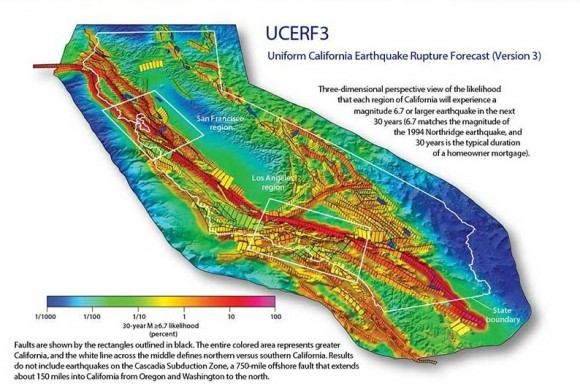
The U.S. Geological Survey (USGS) released a new California earthquake forecast last week (March 10, 2015). The new report slightly raises the likelihood of big earthquakes over the next several decades, but lowers chances in some regions of smaller, magnitude-6.7 quakes. The forecast also revises estimates about how future earthquakes will likely be distributed across the state.
The Third Uniform California Earthquake Rupture Forecast, or UCERF3, improves upon previous models by incorporating the latest data on the state’s complex system of active geological faults, as well as new methods for translating these data into earthquake likelihoods.
Compared to the previous assessment issued in 2008, UCERF2, the estimated rate of earthquakes around magnitude 6.7 – the size of the destructive 1994 Northridge earthquake – has gone down by about 30 percent. The expected frequency of such events statewide has dropped from an average of one per 4.8 years to about one per 6.3 years.
However, in the new study, the estimate for the likelihood that California will experience a magnitude 8 or larger earthquake in the next 30 years has increased from about 4.7% to about 7.0%.
USGS scientist Ned Field is lead author of the study. He said:
The new likelihoods are due to the inclusion of possible multi-fault ruptures, where earthquakes are no longer confined to separate, individual faults, but can occasionally rupture multiple faults simultaneously
The information in the USGS report helps set earthquake insurance rates and building codes in California.
Tom Jordan, Director of the Southern California Earthquake Center is co-author of the study. Jordan said:
We are fortunate that seismic activity in California has been relatively low over the past century. But we know that tectonic forces are continually tightening the springs of the San Andreas fault system, making big quakes inevitable. The UCERF3 model provides our leaders and the public with improved information about what to expect, so that we can better prepare.
Bottom line: A new long-term earthquake forecast for California – the The Third Uniform California Earthquake Rupture Forecast, or UCERF3 – was released on March 10, 2015 by the U.S. Geological Survey. The report revises estimates for the chances of large earthquakes over the next several decades and how they are likely to be distributed across the state.











